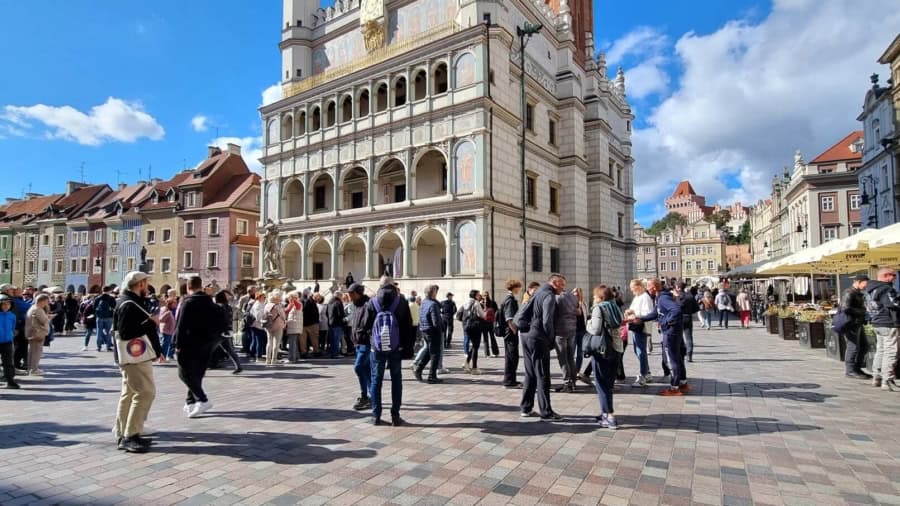I’ve decided to write about some of the best FREE things to do in Poznań because I believe this is a city that’s not that well-known for its museums and paid attractions.
Late September in Poznań – Background
Prior to travelling from Gdańsk to Poznań on September 27, 2024, my wife and I had only returned to Gdańsk from Bosnia the previous weekend. Certainly, I didn’t fancy driving to Poznań after that gruelling 1400-kilometre journey from Bosnia. Therefore, we opted for the delights of Polish rail travel.
This wasn’t my first visit to Poznań. I have some distant relatives in the city who I went to stay with some 17 years ago. Headed by Pani Weronika, they showed me the sights of Poznań and also took me to nearby Kórnik Castle. Sadly, we’ve lost contact. I do wonder whether Pani Weronika is still alive.
My last visit to Poznań was in the summer of 2013. I travelled to the city by bus from Łódz with my friend, Łukasz, and my father. I’d been living and working in Łódź since January 2012 and my time in the city was coming to an end. Anyway, the goal of that particular visit to Poznań, from the perspective of Łukasz and me, was to do some busking in the city centre. We’d built up a steady repertoire of mostly soft rock songs during our jam sessions in Łódź. I took care of the vocals while Łukasz did his thing on guitar. I played guitar as well, though not to the same standard as him.
Unfortunately, I don’t have many memories from this busking session. However, I do know that I didn’t feel as confident as I did when I busked in Kraków in the autumn of 2007.
Gdańsk Główny to Poznań Główny by train
My wife and I caught the 14:05 Intercity train on a Friday from Gdańsk Main Railway Station to Poznań Main Railway Station (Poznań Główny). The journey took around 3 hours and 20 minutes, making six stops before arriving at Poznań Główny.
The journey time from Gdańsk to Poznań depends on the service. Other services during the day tend to take around 3 hours. It’s worth noting that the 09:35 Intercity train from Gdańsk to Poznań only takes 2 hours and 51 minutes. On this route, there are only four stops, as opposed to six, between the two cities – Tczew, Bydgoszcz, Inowrocław and Gniezno. My wife and I returned to Gdańsk on Monday on the faster service which leaves Poznań at 15:32. The journey takes 2 hours and 52 minutes.
Most Intercity cars are open-plan with a central aisle and two seats on either side. However, several trains comprise six-seat compartments. Frankly, these six-seat compartments take me back to the good old days between 2006-2008 when I mostly travelled on TLK trains. Those were the days when it would be normal to converse with your fellow passengers. Good days indeed.
My six-seat compartment contained no other than my wife, me, a young couple in mobile phone land, a guy sporting a smartwatch (hihi) and a chap to my right who spent 200 minutes straight gazing at his laptop screen. I swear he did not look up from the screen for a single second. No chance of a return to the good old days in this compartment. I probably should have initiated a blazing barney with the wife to jolly the compartment up.
Anyway, the 3 hours and 20 minutes passed quickly. I had a Bill Bryson book to keep me amused. It’s possible that I dozed off as well.
As things stand, second class tickets cost 70,00 zł while a first class seat will set you back 92,00 zł. Rather fair I would say.
Exploring Poznań on foot
If you’re looking for free things to do in Poznań, it’s natural that you’ll be on your feet for most of the time. There’s plenty of sightseeing to be done in one of Poland’s oldest cities, as I shall now go into:
1. Soak up the Atmosphere on Poznań’s Old Town Square by Night
On our very first evening in Poznań, a warm one by late September standards, we took a 15-minute walk from our hotel to the Old Market Square (Stary Rynek).
It was a Friday night. Jovial people were out and about doing their thing. But it was the magnificent facades of the square’s townhouses, multicoloured merchants’ houses and the Old Town Hall which stole the show. On this warm night, I could have sat on a bench and marvelled at the townhouses for a good hour, or two.
More to come on the Old Town Square soon.
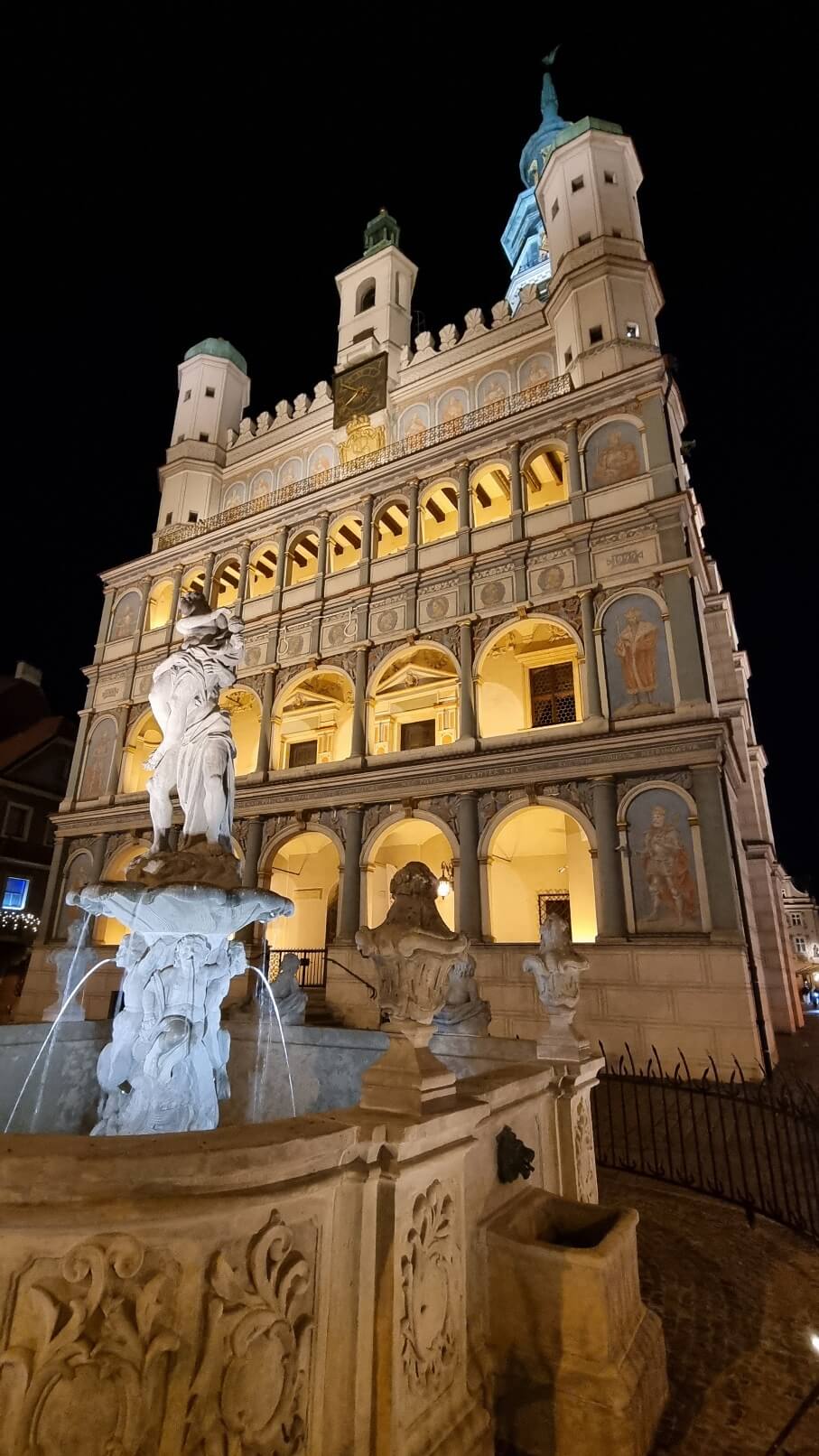
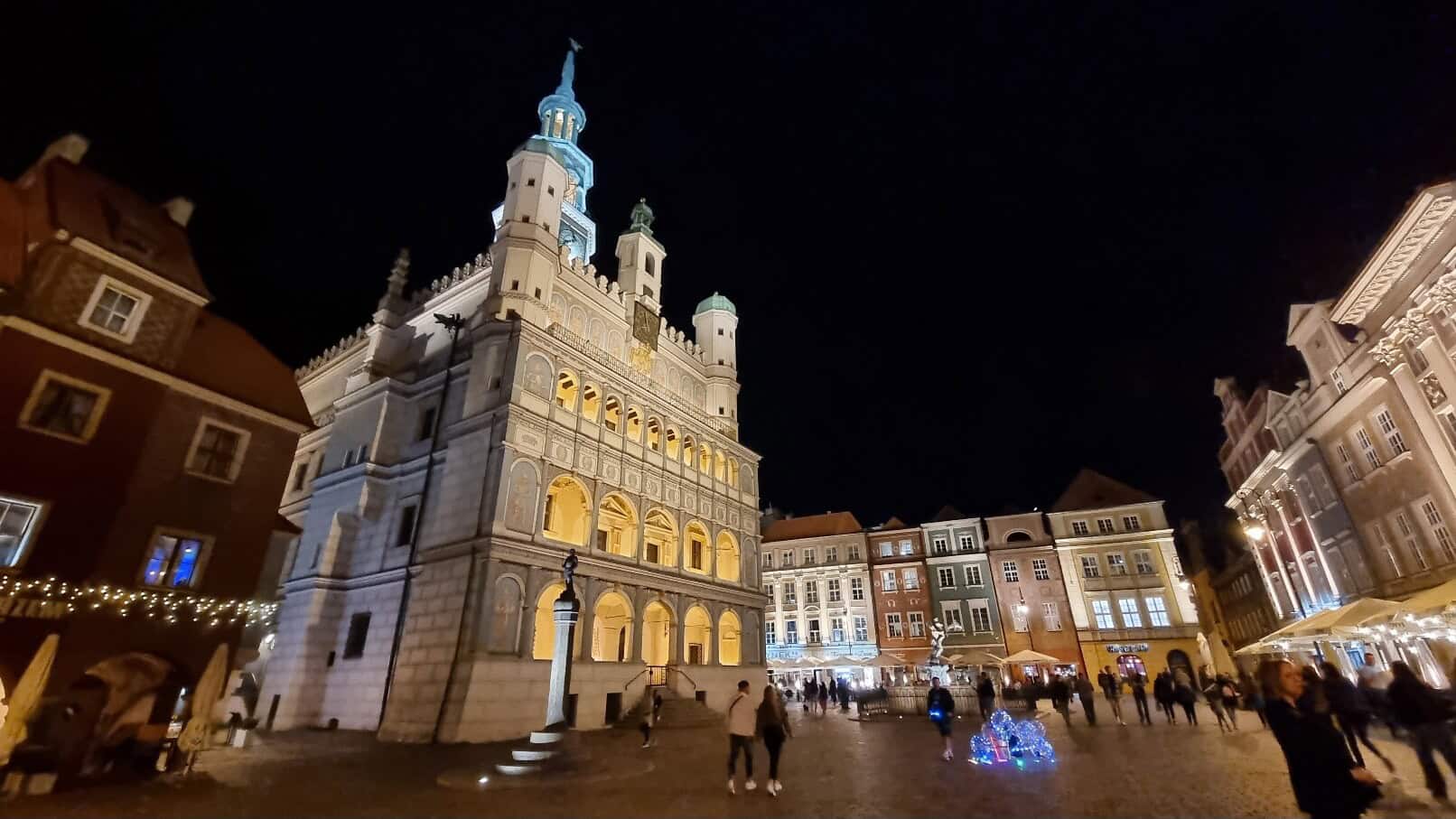
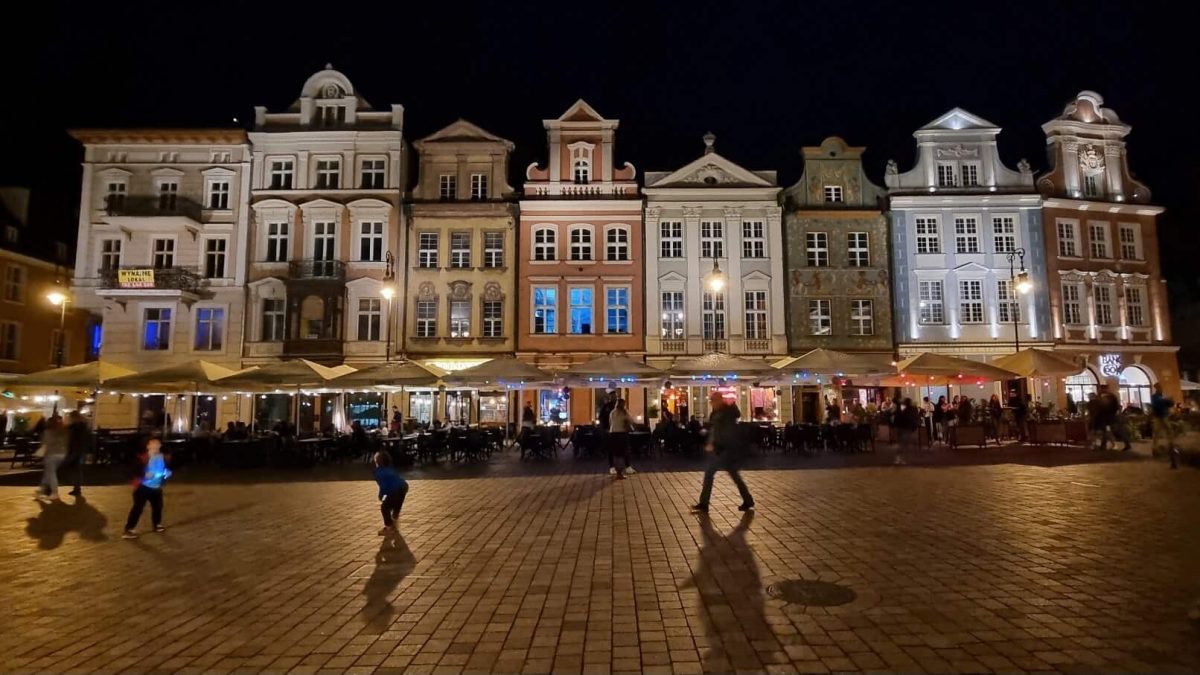
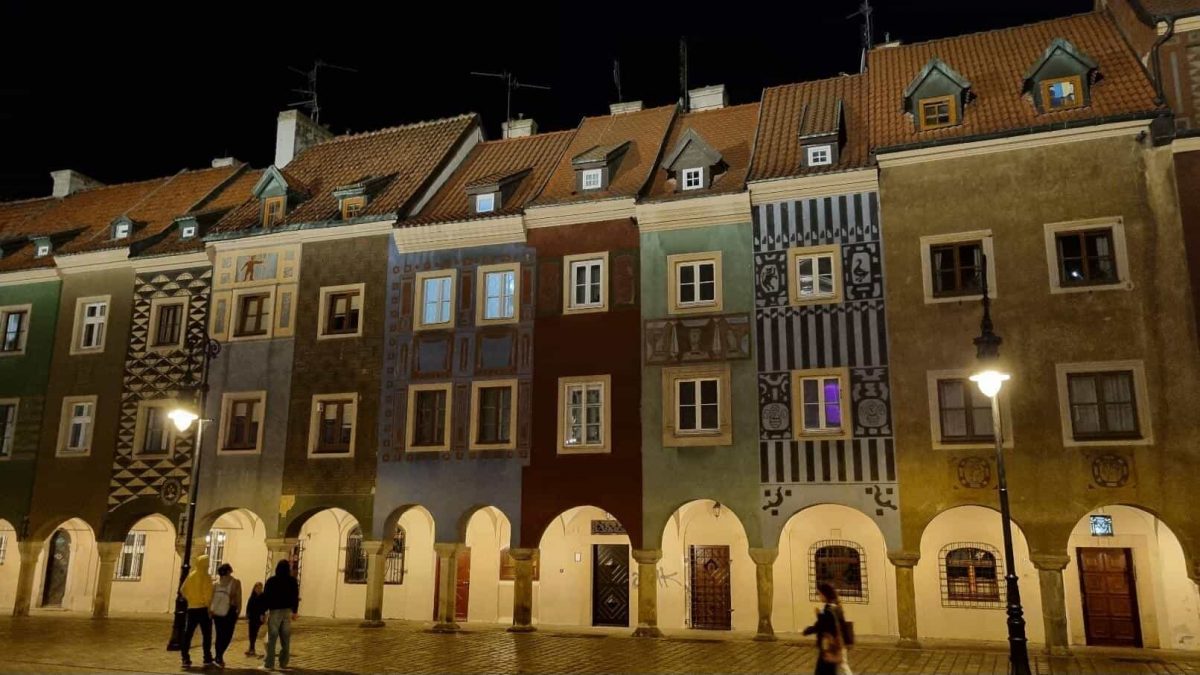
2. Check out the exterior and interior details of the Catholic church, Poznań Fara
After drinking coffee in our much beloved cake and coffee shop, Cukiernia Sowa (located next to McDonald’s on Półwiejska Street), we went to visit the Catholic church, Poznań Fara. Informally, the church is known as the Poznan Fara. However, its full name is the Basilica of Our Lady of Perpetual Help, Saints Mary Magdalene and Stanislaus of Szczepanów.
Poznań Fara is one of the most graceful examples of Baroque architecture in Poland. With enormous Corinthian columns and a most breathtaking cupola fresco, the interior of the church is equally as impressive as the church’s northern facade.
Entrance to the church is free.

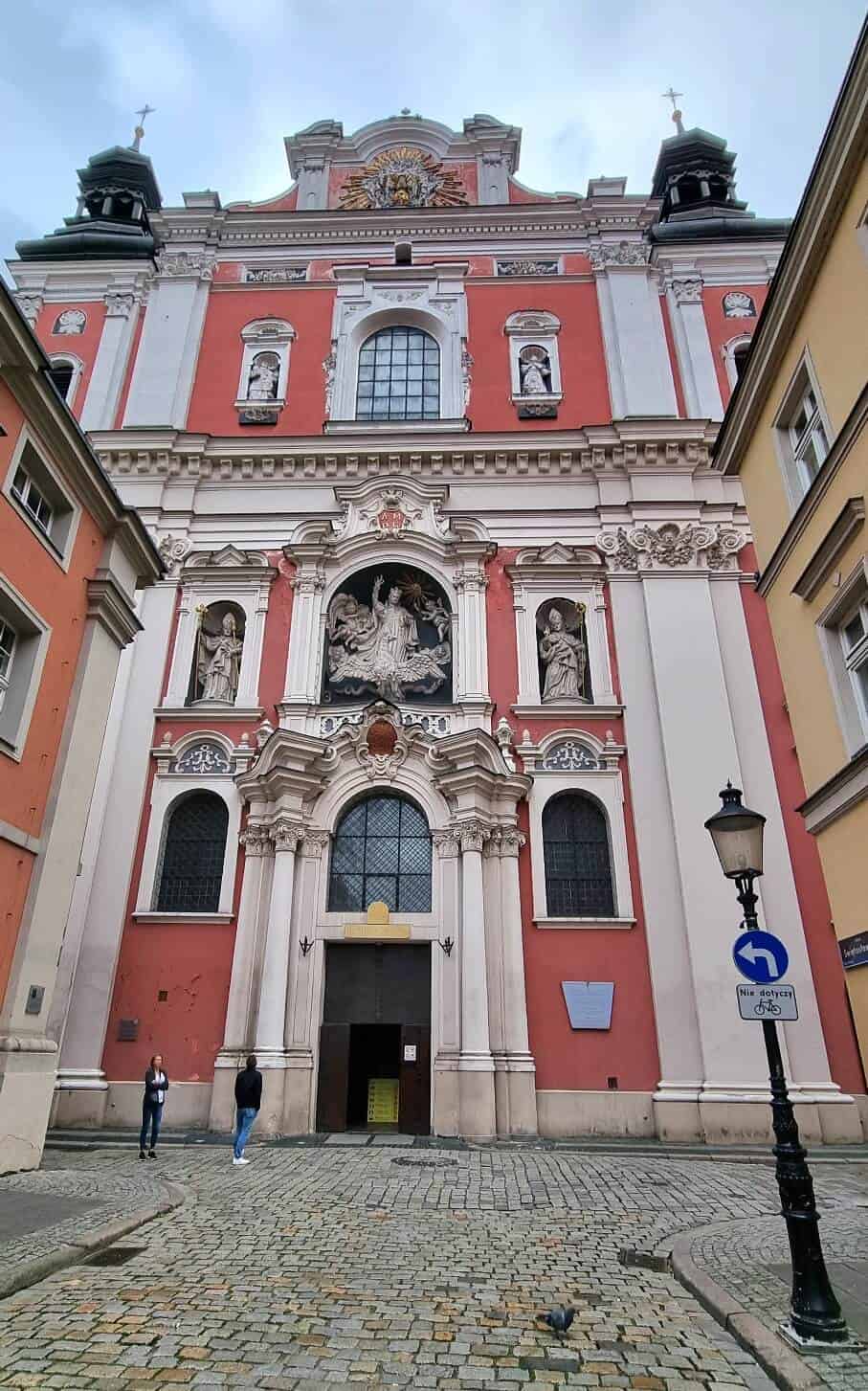
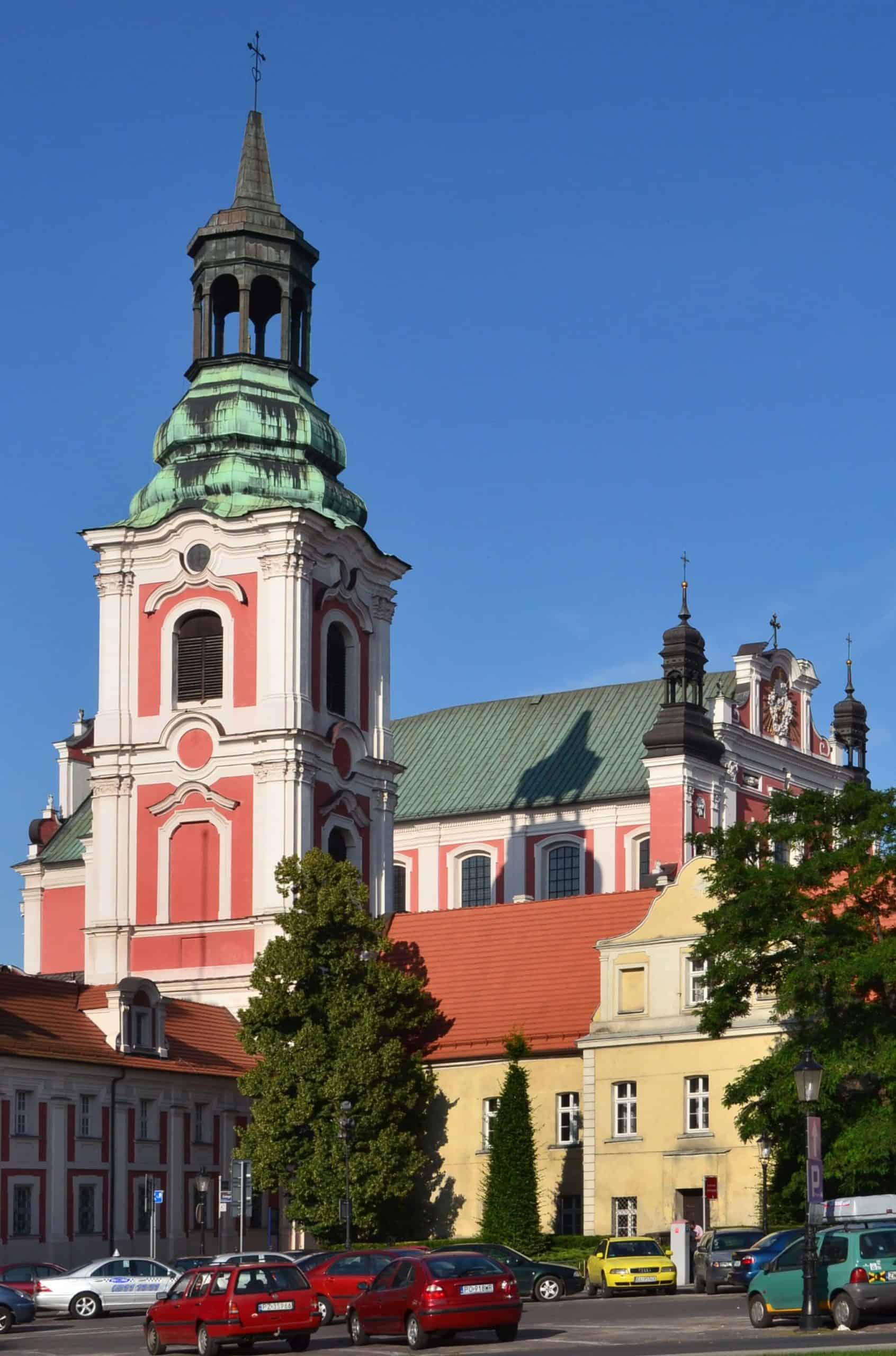
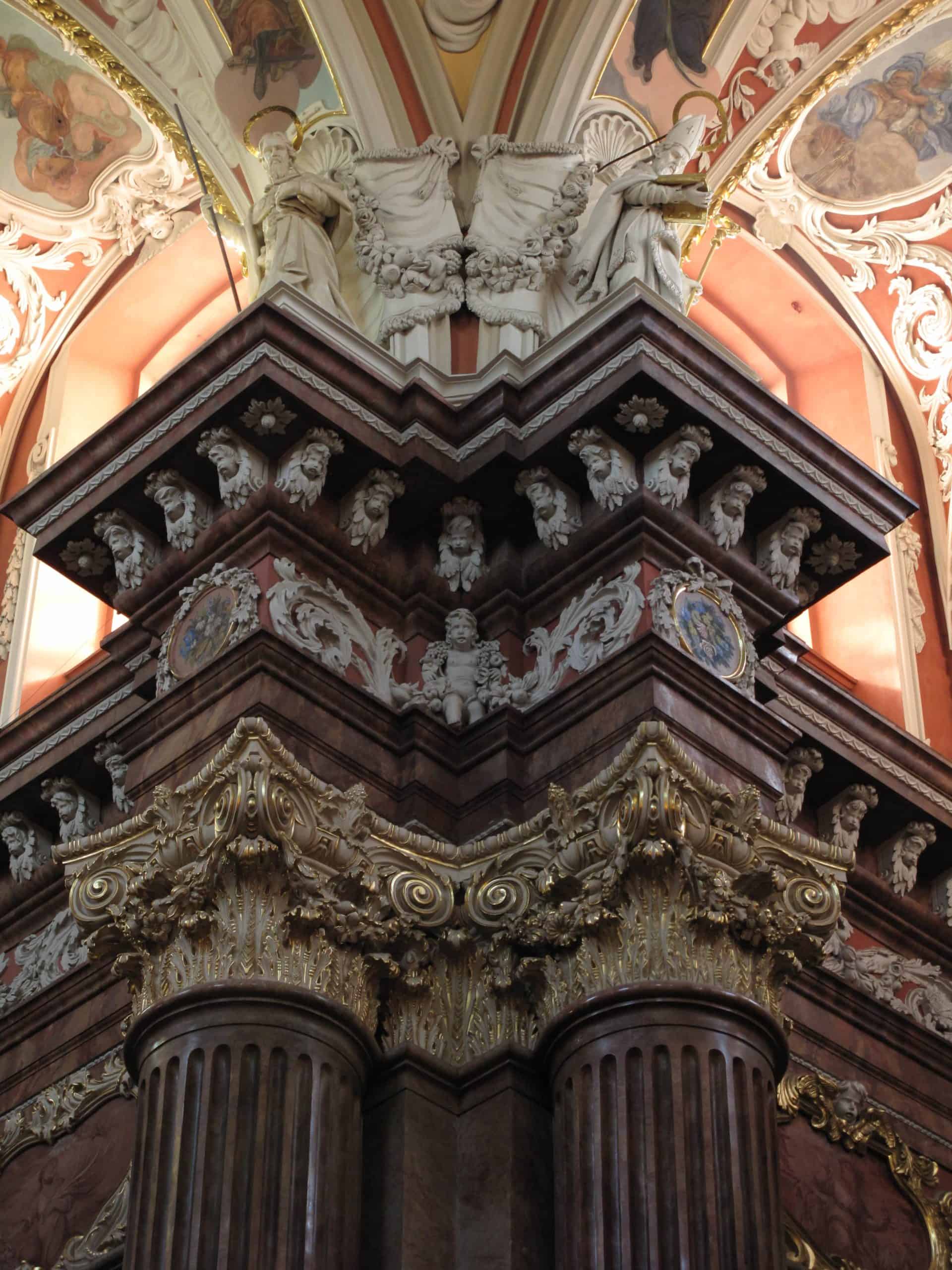
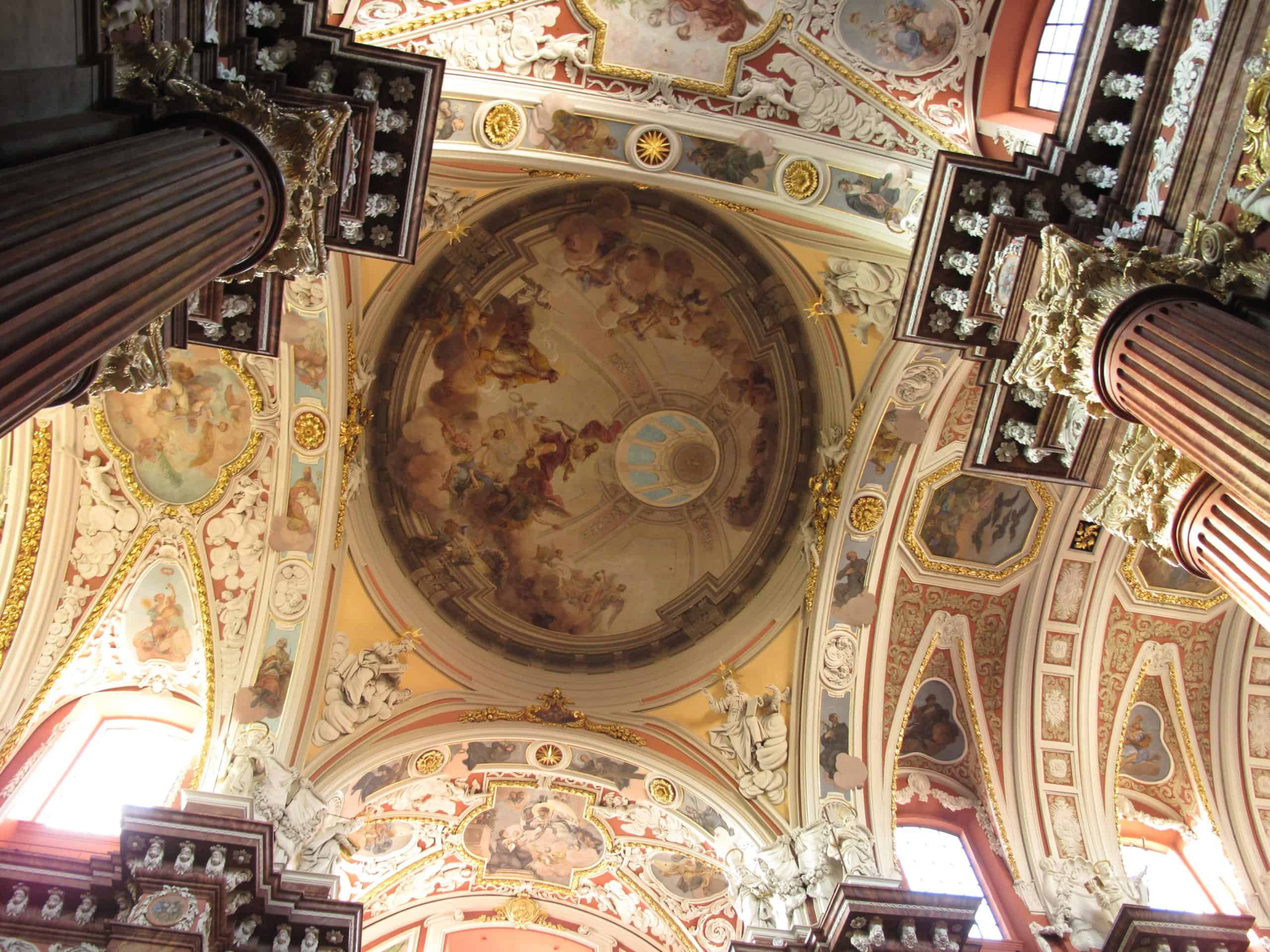
3. Take in the architecture on the Old Town Square
As impressive as the Old Town Square is when darkness falls, nothing beats taking a slow amble around the square during the daytime when you can see the Renaissance City Hall, merchants’ houses and tenement houses in their full colours.
Merchants’ houses
If you’re looking to feast your eyes on some unique relics of early commercial architecture in Poznań, you won’t go far wrong with the merchants’ houses (Domki Budnicze w Poznaniu).
Back in 1418, the local authorities put 17 herring stalls into use, hence the arcades’ old name “herring stalls”. In the early days, fish, candles, torches and salt were traded.
At the beginning of the 16th century, some of the buildings received brick arcades. In 1534, the city authorities agreed for the guild of merchants to build arcades for all buildings. The current name of the buildings refers to the seat of the guild Brotherhood of Merchants, which was located in tenement house no. 17. This is evidenced by the coat of arms with three palms and a herring and the signature Fraternitatis Budnicorum.
Over time, the arcades were bricked up, creating small shops. The tenement houses were almost completely destroyed during World War II. After the war, the arcades were reconstructed using original architectural details inspired by the Renaissance style. The narrow, single and double-window facades of most of the tenement houses are covered with polychromes designed by Polish artist, Zbigniew Bednarowicz. To this day, the arcades are a place of trade, with souvenirs the main focus of trading.
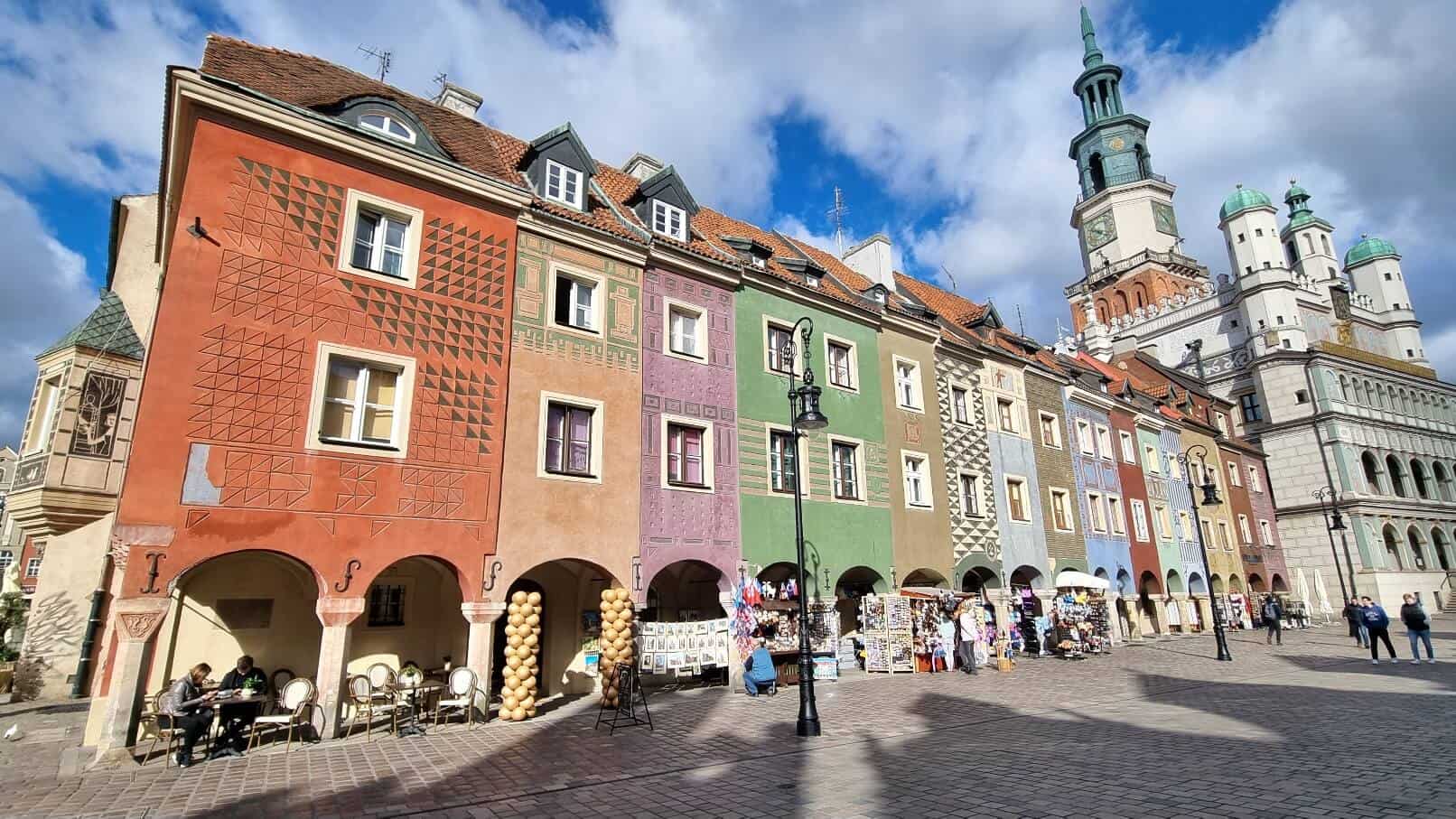
The Colour Renaissance Facades of the Tenement Houses
On all four sides of the square, there are tall rows of former tenement houses (kamienice). The vast majority of these buildings are now occupied by restaurants, cafés and pubs. Regardless of their function, the architecture is a sight to behold.
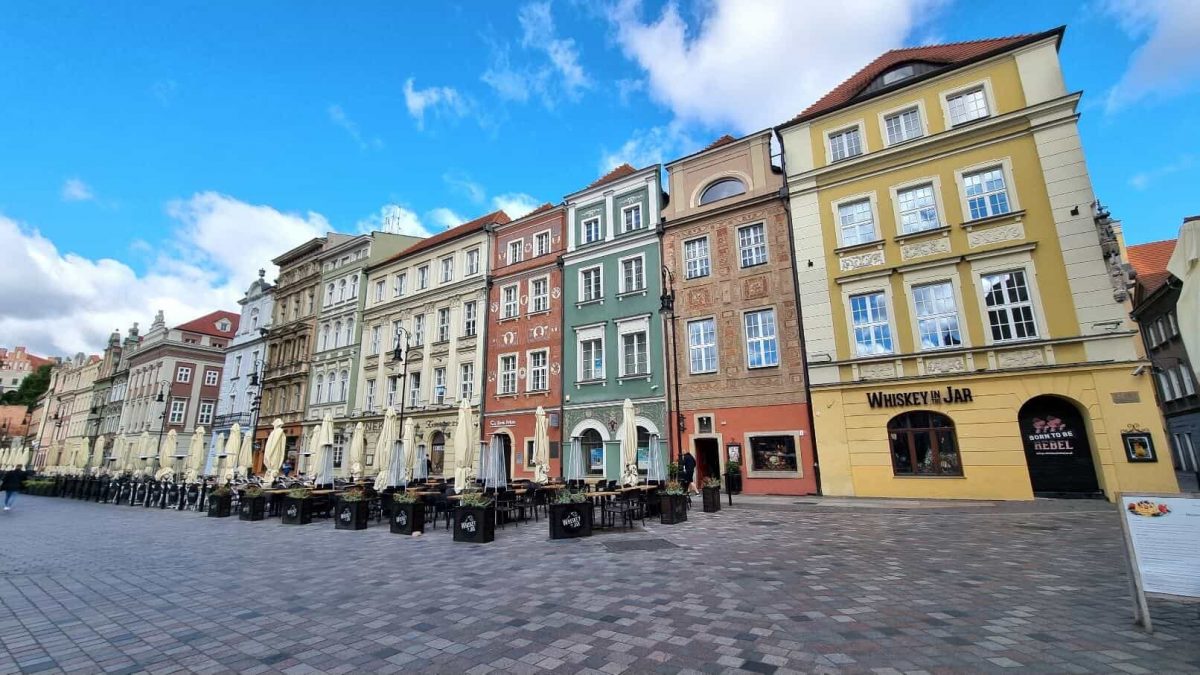
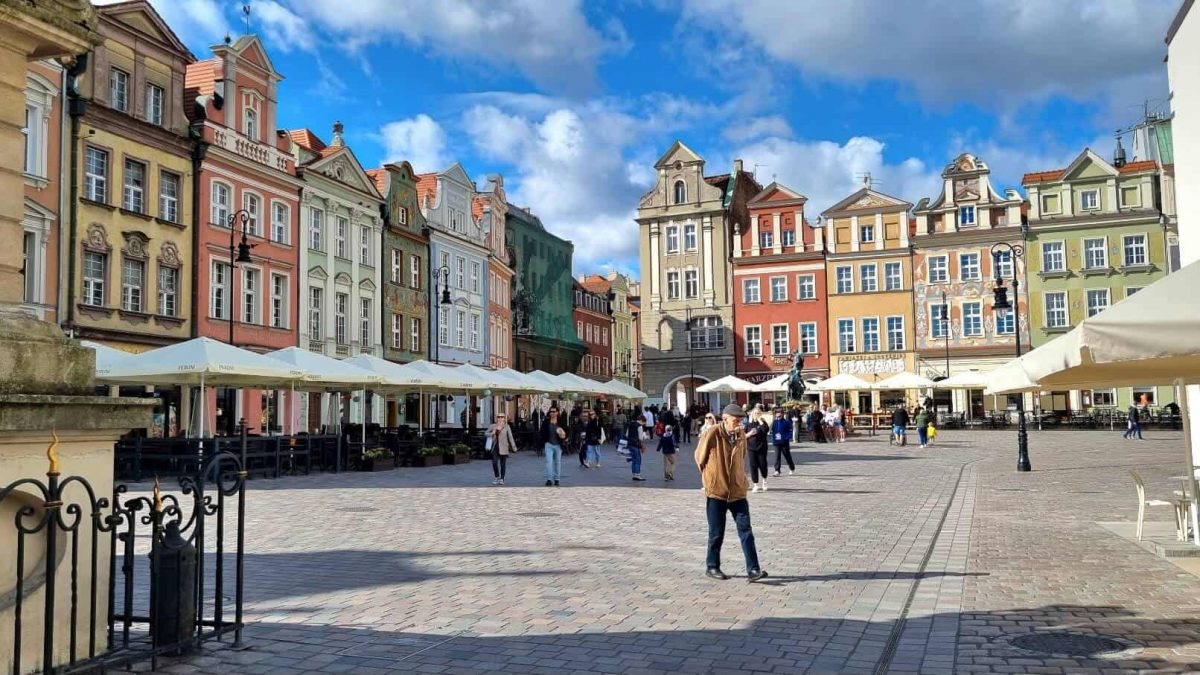
4. Observe the Goats butting heads at the top of the City Hall Tower
Perhaps the most iconic symbol of Poznań is the mechanical goats which emerge from the tower of the City Hall every day at noon to butt heads.
The tale of the mechanical goats dates back to the mid-16th century. First of all, we must go back to 1536 – the year Poznań suffered a major fire. The town hall was severely damaged. Consequently, after a rushed repair job in the early 1540s, the town hall was thoroughly reconstructed between 1550 and 1560. The local authorities commissioned a grand clock from master craftsman Bartłomiej of Gubin. Adorned with effigies of two goats and three shields, the clock was installed on the town hall tower in 1551.
Given the extravagance of Bartłomiej’s craftsmanship – a clear showcase of Poznan’s wealth – the city council organised a grand feast to celebrate the installation of the clock. The Legend of the Goats is connected with the preparations for the feast, as I shall now explain.
The Legend of Pietrek and the Goats
As the kitchen team had a great deal of work on its hands, the chef assigned a young kitchen boy by the name of Pietrek to spit-roast a venison leg, the main course for the event.
While the venison was roasting, Pietrek’s curiosity about the excitement outside and indeed the clock mechanism got the better of him. Hence, Pietrek left the roast to observe the clock. However, in his absence, the roast fell off the grill and straight into the fire. Desperate to avoid punishment, Pietrek ran to a nearby meadow and grabbed two billy goats which he brought back to the kitchen in the hope that they could replace the burnt roast. Nevertheless, the goats escaped and ran to the cornice of the town hall tower.
In plain view of the townspeople on the square, the goats began to butt each other with their horns. The sight of the goats butting heads was such a spectacle for the mayor and the invited guests that the mayor forgave Pietrek. To commemorate this memorable and humorous event on a daily basis, the mayor instructed the clockmaker, Bartłomiej of Gubin, to create a mechanical device which featured the two goats.
A History of Poznań’s Mechanical Goats
As previously mentioned, the mechanical goats first appeared on the Town Hall tower in 1551. However, a lightning strike destroyed the tower, including the clock and the goats, in 1675. The goats would not return to the tower until the early 20th century, only to be damaged again in the Battle of Poznań in 1945.
After the reconstruction of the tower and the renovation of the City Hall, the goats returned to their place in 1954. The current figures, which closely resemble the original figures, were created in 1993, moved by a modern control mechanism designed by Dr. Stefan Krajewski from the Poznań University of Technology.
The mechanical goats emerge from the tower to butt heads 12 times. This fierce butting display is accompanied by the playing of the traditional bugle call of Poznań (Hejnał Poznania).
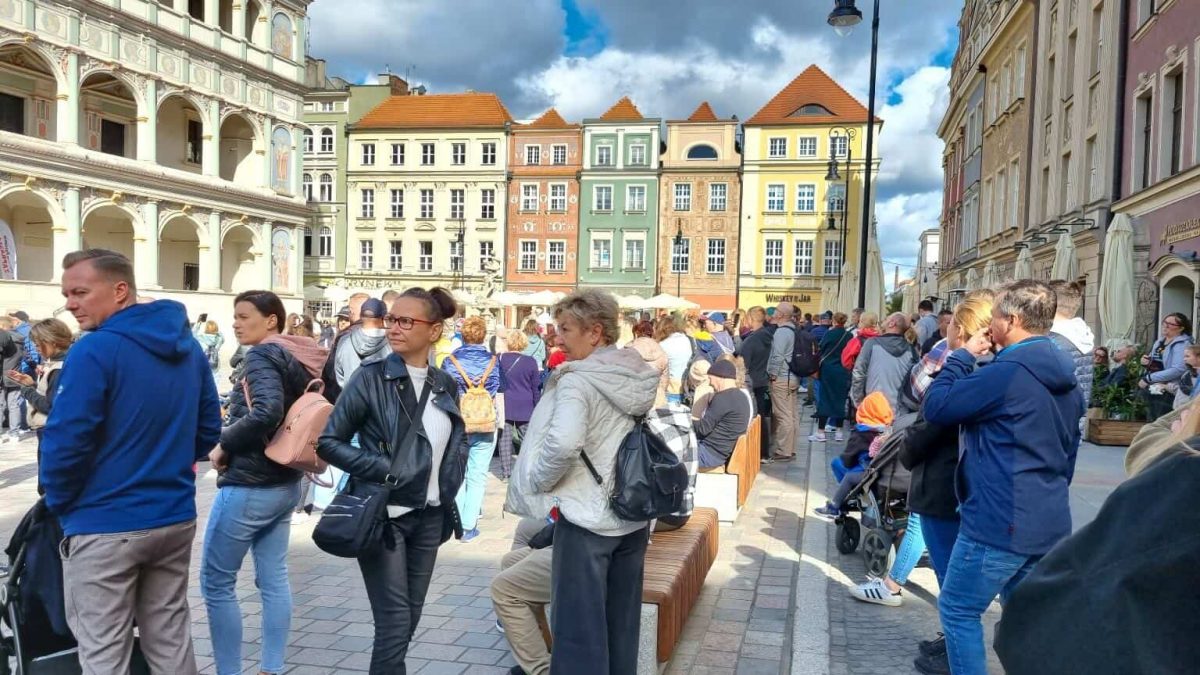
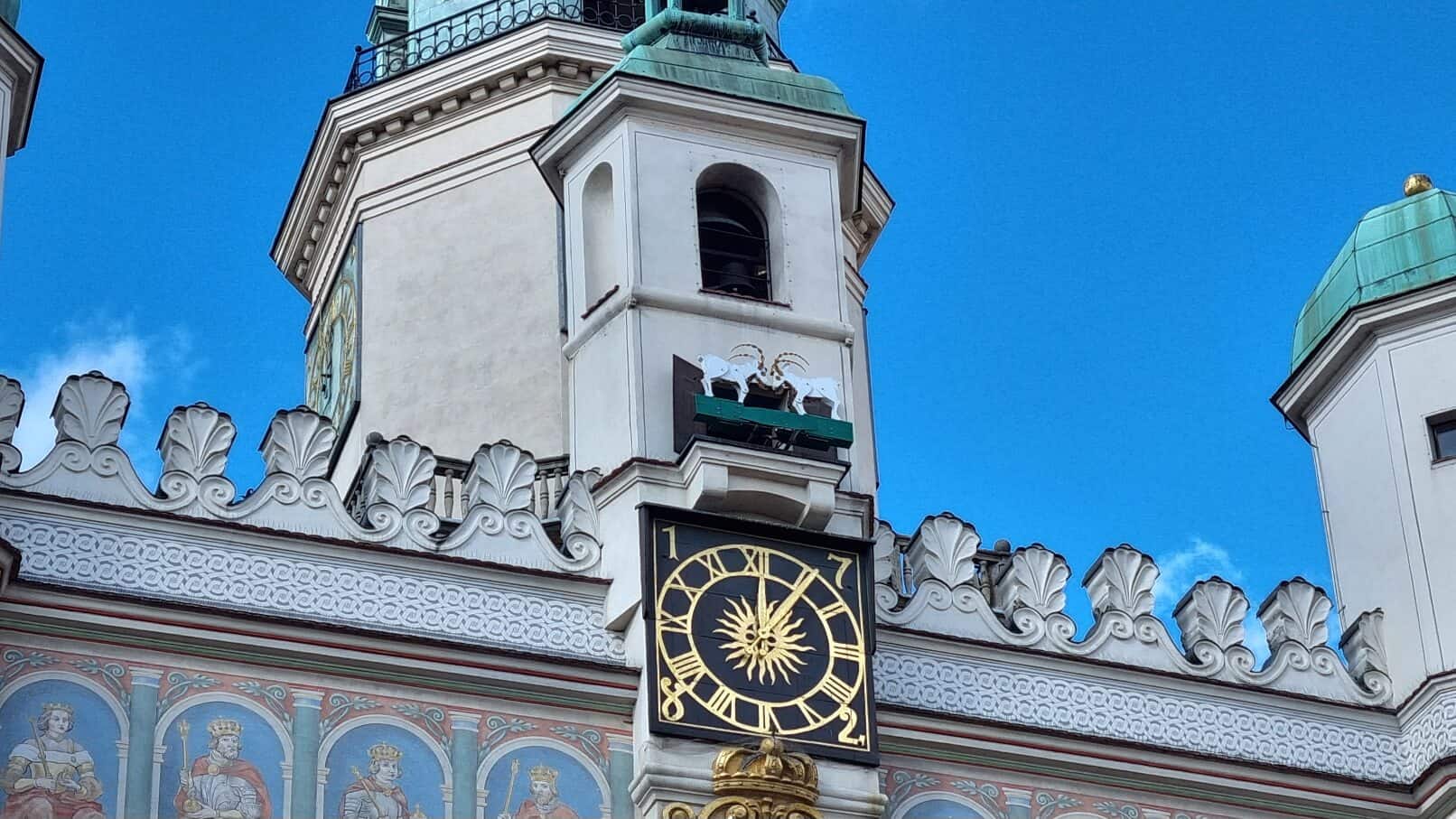
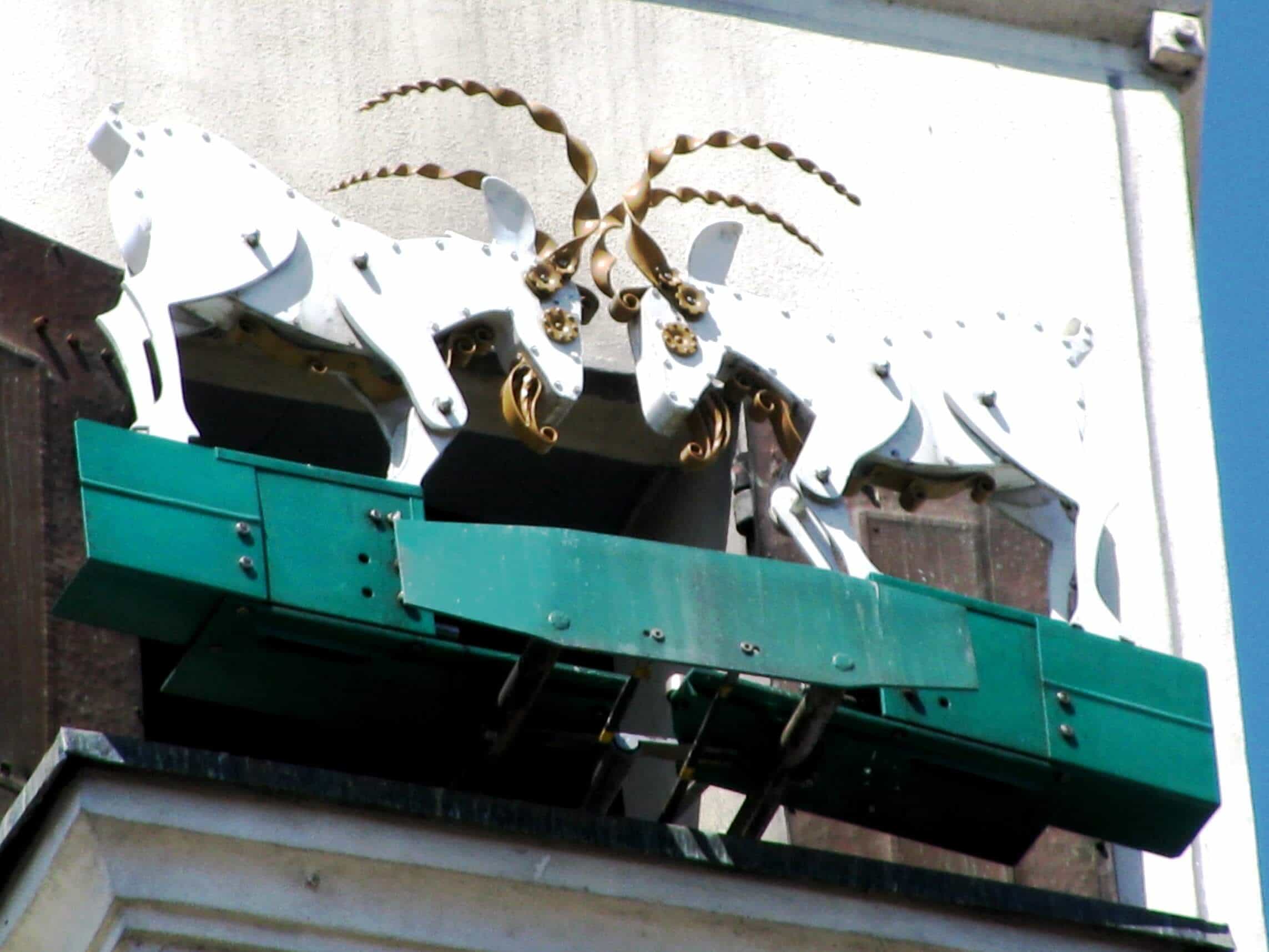
5. Wander around the grounds of the Imperial Castle and the Imperial Quarter
Those looking for free things to do in Poznań won’t go far wrong with visiting the grounds of the Imperial Castle (Zamek Cesarski) and the Imperial Quarter (Dzielnica Cesarska).
The Imperial Castle
In brief, the Imperial Castle was constructed in the years 1905-1910 as the provincial residence of the last German Emperor, Wilhelm II. The designer of the Imperial Castle was Franz Schwechten, one of the most famous German architects of the Wilhelmine era. Given the elegance of the building and the effort that went into constructing it, it’s surprising that Emperor Wilhelm II visited Poznań only three times.
It’s important to state that the building is a palace. Therefore, the name of the building (zamek = castle) is misleading. Another discrepancy emerges from the adjective imperial (cesarski), preferred by the Poles, and royal (königliches), used by the Germans. The German name refers to Wilhelm II as King of Prussia. In contrast, the Polish name refers to Wilhelm as German Emperor because the term “royal” is reserved for Poznań’s Royal Castle.
These days, the palace is run by a cultural entity, Centrum Kultury Zamek. It is possible to visit the interior of the palace for a small fee (15 zł for adults, 12 zł for concessions). Frankly, I was content with roaming around the grounds of the palace, surely one of the most intriguing free things to do in Poznań.
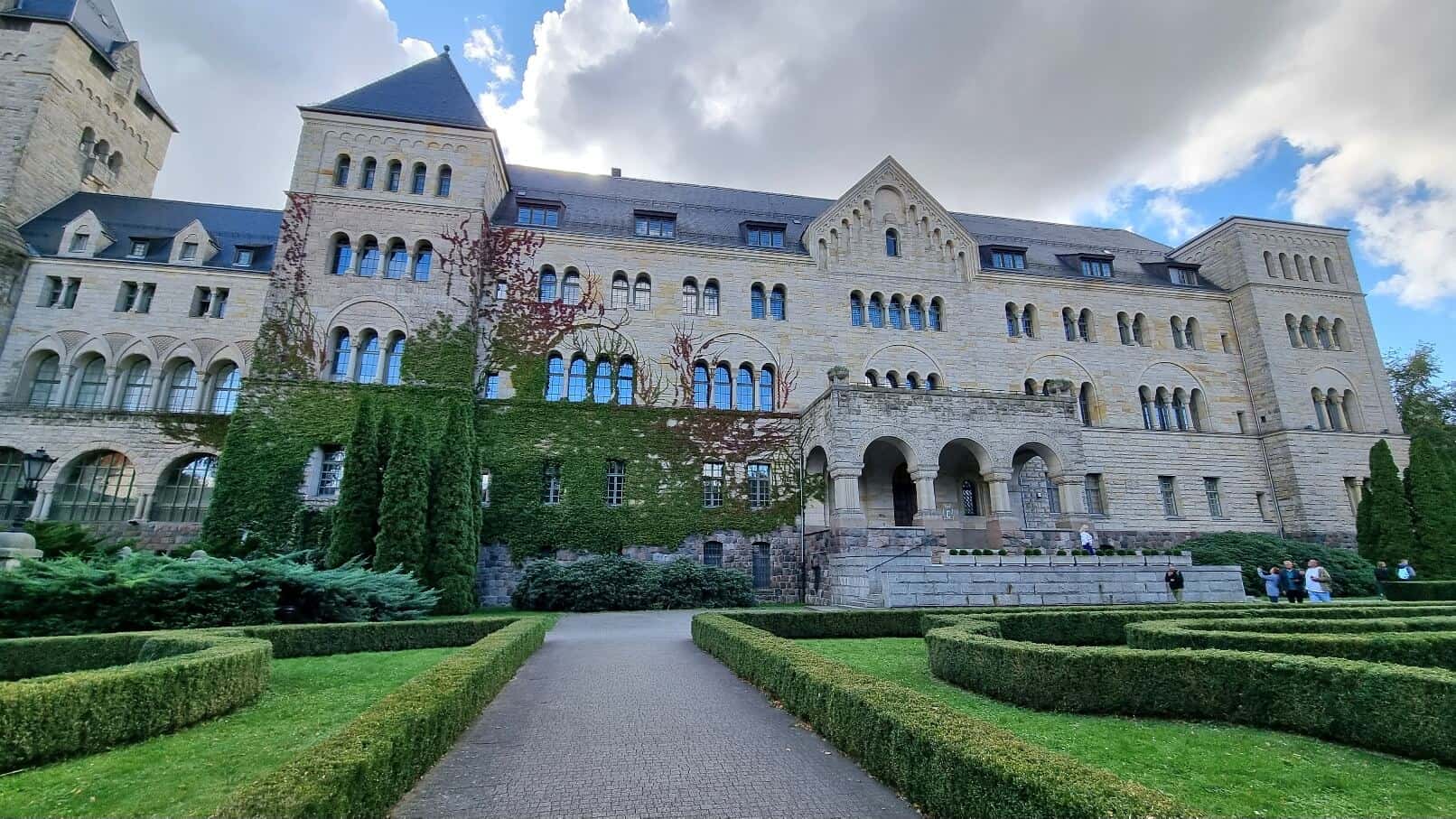
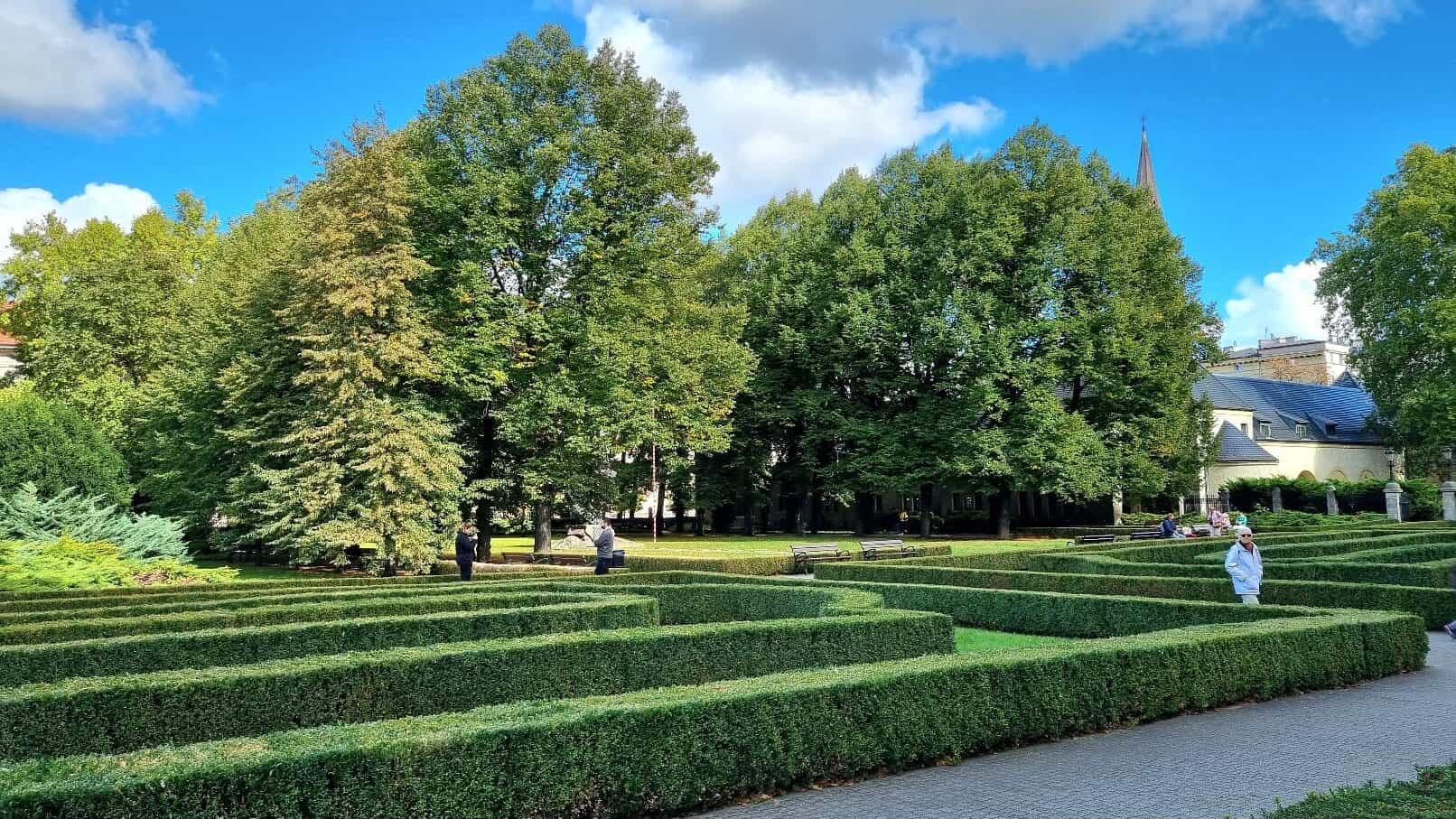
The Imperial Quarter
The Imperial Castle is undoubtedly the focal point of what is known as the Imperial District. However, it’s worth crossing over Aleja Niepodległości (Independence avenue) to see further architectural wonders, important monuments and well-kept green spaces.
First of all, you won’t fail to miss two monuments – one to poet Adam Mickiewicz and the other to the Victims of June 1956. Also known as Poznań June, the 1956 protests in Poznań were the first in a series of protests against the communist government of the Polish People’s Republic:
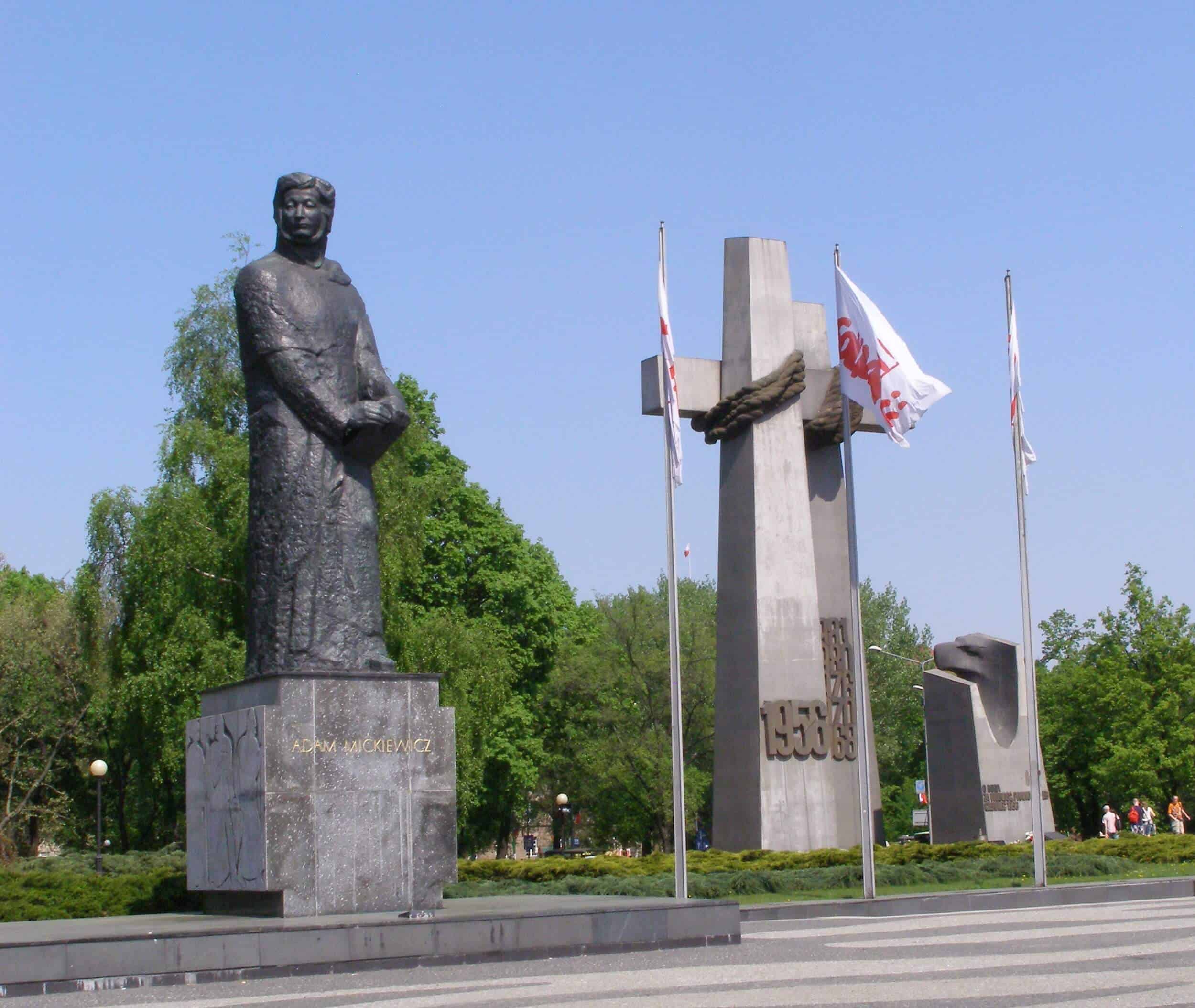
Just beyond Adam Mickiewicz Square, there is Collegium Minus – a historic, neo-Renaissance building which is part of Adam Mickiewicz University. It houses a number of university departments as well as the Rector’s Office and the University Hall:

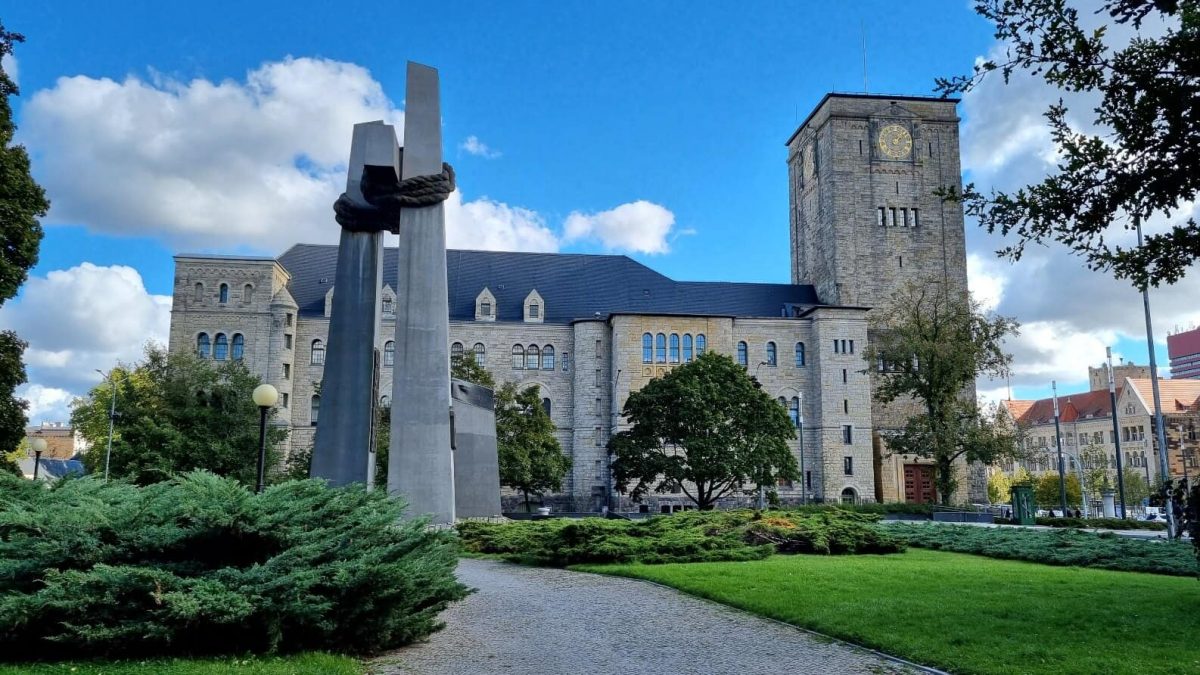
If you walk 20 metres away from the Monument to the Victims of June 1956 in the direction of Collegium Minus, you’ll be greeted with a wonderful view of the Grand Theatre (Teatr Wielki im. Stanisława Moniuszki) with a beautiful fountain to boot. We’re in the midst of Mickiewicz Park – small but ever so charming:
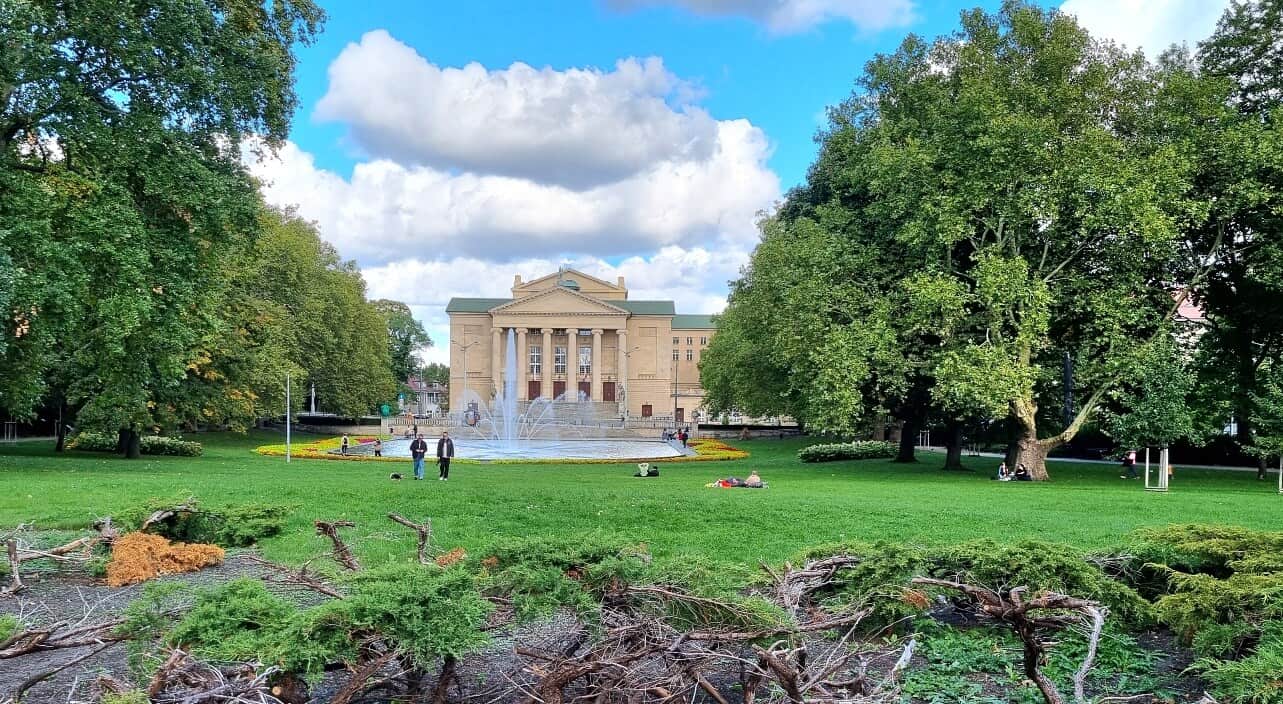
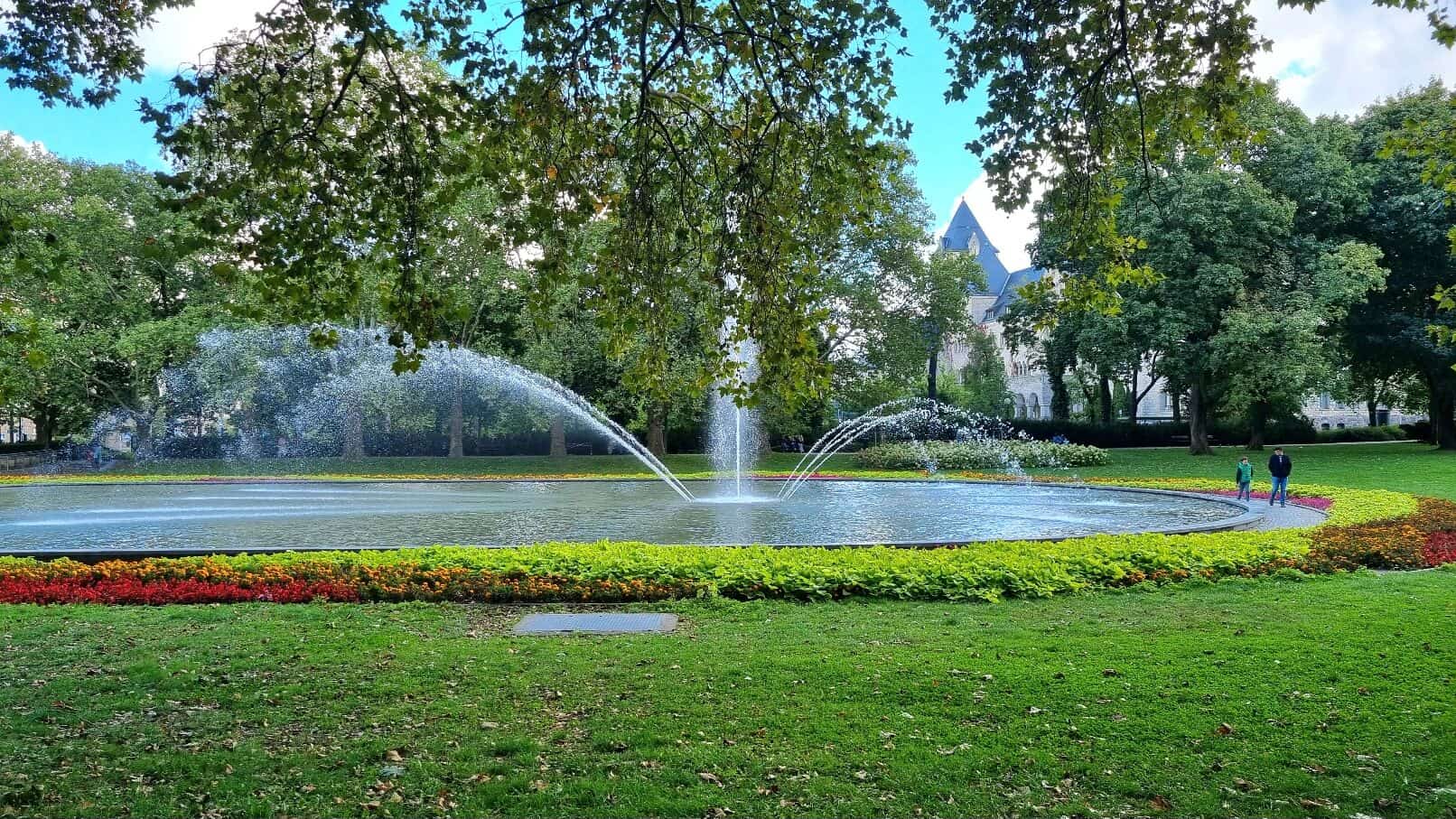
6. Lose yourself amidst charming greenery and nature in Citadel Park
But a 15-minute walk away from the Old Town Square is Citadel Park. It is Poznań’s largest green space occupying some 100 hectares of green space.
Citadel Park is situated on the site of Fort Winiary, a system of defensive fortifications around Poznań. Constructed under Prussian rule in the nineteenth century, Fort Winiary surprisingly remained intact until it was destroyed during the Battle of Poznań in 1945.
Citadel Park contains military cemeteries, eye-catching monuments (several with links to Soviet times), outdoor sculptures, the remains of some of the fortifications, the Armament Museum and the Museum of the Poznań Army.
In terms of recreation, Citadel Park offers bicycle and rollerblade routes, playgrounds and outdoor gym equipment.
Owing to the sheer range of attractions for the public to admire amidst stunningly beautiful promenades, one of the best free things to do in Poznań is to take in the wonders of the picture-perfect green space that is Citadel Park.


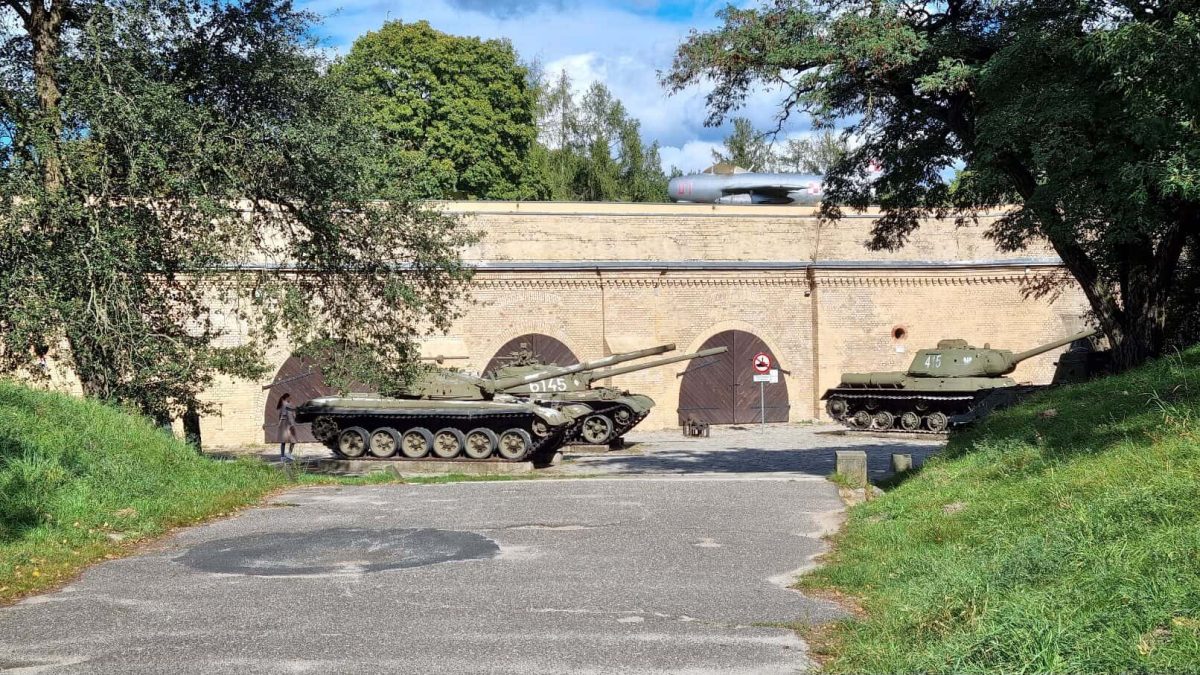

7. Visit The Archcathedral Basilica of St. Peter and St. Paul
The Archcathedral Basilica of St. Peter and St. Paul is located on Tumski Island (Ostrów Tumski), just a 15-minute walk away from the main square.
We need to go back to 968 to appreciate the origins of the first Poznań cathedral. It was in this year that the Poznań diocese was formed. This event occurred just two years after Poland’s first historical ruler, Mieszko I, was baptised (966). The construction of the cathedral was completed at the end of the 10th century.
In the 12th century, the cathedral was rebuilt in the Romanesque style, retaining the shape of the earlier building.
The first mention of the rebuilding of Poznan’s Cathedral in the Gothic Style comes from the period 1243-1262, when Bishop Boguchwał II ordered the demolition of the old choir and sanctuary owing to serious cracks in the walls. Hence, construction of a new, Gothic section of the church began. The main body of the cathedral and the towers of the westwork were also rebuilt. In the 14th and 15th centuries, a ring of chapels, and an ambulatory around the eastern presbytery were added. The Poznań Cathedral obtained its Gothic form (currently reconstructed) at the end of the 15th century.
Two major fires in 1622 and 1772 led to the church being rebuilt, in the Baroque and Neo-Classical styles respectively. The last of the great fires occurred in 1945 when Poznań was captured by the Red Army. Such was the extent of the damage that the conservators decided to return to the Gothic style. Poznań Cathedral reopened on 29 June 1956.

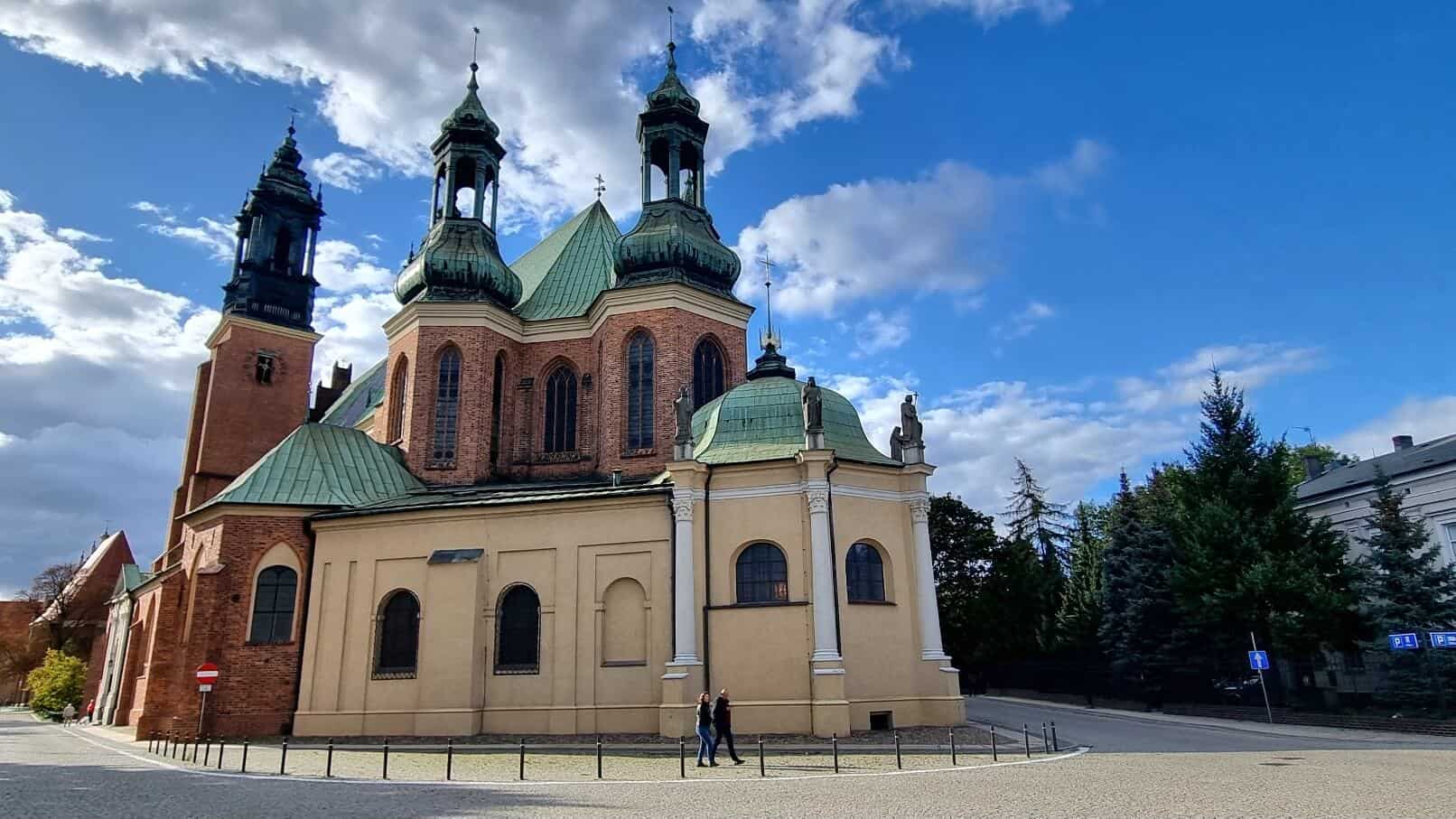
Interior
It’s free to enter Poznań Cathedral. However, you have to pay a small fee (6 zł) to go down to the underground crypts. It is here visitors can see the exposed remains of the pre-Romanesque and Romanesque cathedral, baptistery and relics of tombs of some of the first rulers of Poland. There’s also a burial crypt which contains the remains of Poznan’s archbishops.
I did go down to the crypts and rather regretted it as I could have allowed myself more time to take in the interior of the cathedral. Here are some of the highlights:
- A polyptych in the presbytery from the turn of the 15th and 16th centuries. The central cabinet shows figures of the Blessed Virgin Mary, St. Barbara and St. Catherine. In the inner wings there are twelve holy women grouped in threes;
- The ring of chapels which escaped major damage during the fire in 1945. Their original decor has been preserved to this day. Notable chapels include the Golden Chapel (of Polish Kings), the Chapel of St. Martin and the Chapel of St Joseph;
- The predella, containing a scene of the Last Supper.
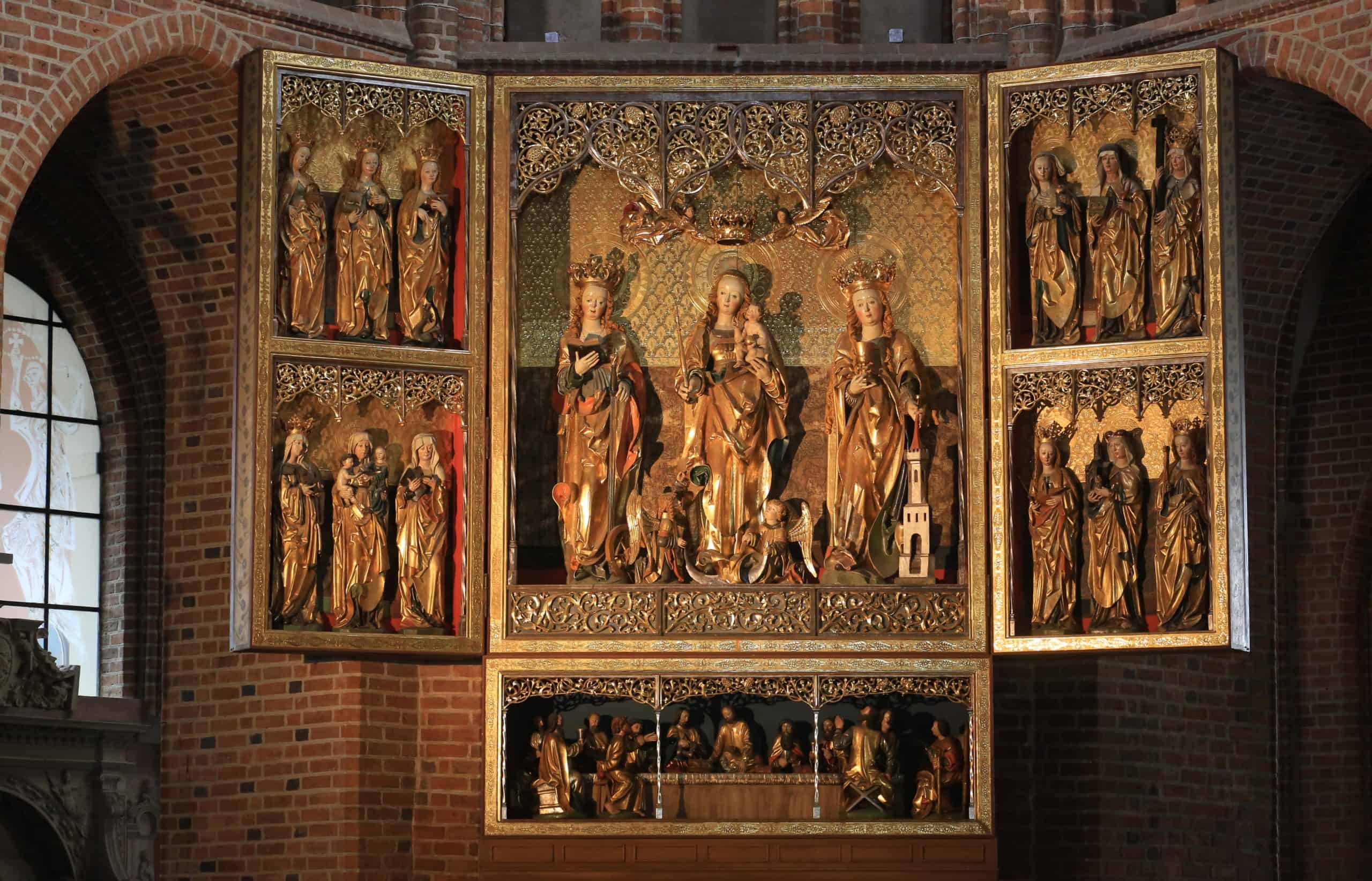

Free Things to do in Poznań
There are plenty of free things to do in Poznań away from the museums and tourist trap stalls on the main square which entice visitors with colourful overpriced tat.
If the weather’s nice, another idea would be to take a short walk from Poznań Cathedral to Lake Malta. The lake is surrounded by woodlands and parks. There is a miniature train which runs along the northern shore of the lake. It costs 15 zł to get to the New Zoo and 30 zł for a return ticket. Based on reviews I’ve read, many people were fooled into thinking that paying 15 zł would take them to New Zoo and back again to Maltanka Station.
Finally, one of the highlights of my visit to Poznań was listening to the soft rock sounds of buskers, especially Tomasz Trzeszczyński on the Old Town Square.

